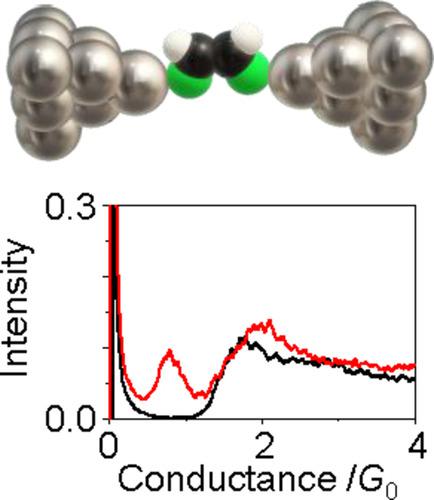当前位置:
X-MOL 学术
›
ChemPhysChem
›
论文详情
Our official English website, www.x-mol.net, welcomes your
feedback! (Note: you will need to create a separate account there.)
Structure and Electron Transport at Metal Atomic Junctions Doped with Dichloroethylene.
ChemPhysChem ( IF 2.3 ) Pub Date : 2020-01-07 , DOI: 10.1002/cphc.201900988 Risa Fukuzumi 1 , Satoshi Kaneko 1 , Shintaro Fujii 1 , Tomoaki Nishino 1 , Manabu Kiguchi 1
ChemPhysChem ( IF 2.3 ) Pub Date : 2020-01-07 , DOI: 10.1002/cphc.201900988 Risa Fukuzumi 1 , Satoshi Kaneko 1 , Shintaro Fujii 1 , Tomoaki Nishino 1 , Manabu Kiguchi 1
Affiliation

|
We have investigated the structure and electron transport at dichloroethylene‐doped metal atomic junctions at low temperatures (20 K) in ultra‐high vacuum, using Fe, Ni, Pd, Cu, Ag, and Au. The metal atomic junctions were fabricated using the mechanically controllable break junction technique. After introducing the dichloroethylene (DCE), the conductance behavior of Fe, Ni, and Pd junctions was considerably changed, whereas little change was observed for Cu, Ag, and Au. For the Pd and Cu junctions, a clear peak was observed in their conductance histograms, showing that the single‐molecule junction was selectively formed. To investigate the structure of the metal atomic junctions further, their plateau lengths were analyzed. The length analysis revealed that the Au atomic wire was elongated, and the metal atomic wires were formed for the other transition metals: those that do not normally form metal atomic wires without DCE doping, as DCE adsorption stabilized the metal atomic states. There is a strong interaction between DCE and the metals, where DCE supports the formation of the metal atomic wire for Fe, Ni, and Pd.
中文翻译:

掺杂二氯乙烯的金属原子结处的结构和电子传输。
我们使用Fe,Ni,Pd,Cu,Ag和Au在超高真空下研究了二氯乙烯掺杂的金属原子结在低温(20 K)下的结构和电子传输。金属原子结是使用机械可控的断裂结技术制造的。引入二氯乙烯(DCE)后,Fe,Ni和Pd结的电导行为发生了很大变化,而Cu,Ag和Au的变化很小。对于Pd和Cu结,在其电导直方图中观察到一个清晰的峰,表明单分子结是选择性形成的。为了进一步研究金属原子结的结构,分析了它们的平台长度。长度分析表明,金原子线拉长了,并为其他过渡金属形成了金属原子线:在没有DCE掺杂的情况下通常不会形成金属原子线的金属原子线,因为DCE吸附稳定了金属原子态。DCE与金属之间存在很强的相互作用,其中DCE支持形成Fe,Ni和Pd的金属原子线。
更新日期:2020-01-07
中文翻译:

掺杂二氯乙烯的金属原子结处的结构和电子传输。
我们使用Fe,Ni,Pd,Cu,Ag和Au在超高真空下研究了二氯乙烯掺杂的金属原子结在低温(20 K)下的结构和电子传输。金属原子结是使用机械可控的断裂结技术制造的。引入二氯乙烯(DCE)后,Fe,Ni和Pd结的电导行为发生了很大变化,而Cu,Ag和Au的变化很小。对于Pd和Cu结,在其电导直方图中观察到一个清晰的峰,表明单分子结是选择性形成的。为了进一步研究金属原子结的结构,分析了它们的平台长度。长度分析表明,金原子线拉长了,并为其他过渡金属形成了金属原子线:在没有DCE掺杂的情况下通常不会形成金属原子线的金属原子线,因为DCE吸附稳定了金属原子态。DCE与金属之间存在很强的相互作用,其中DCE支持形成Fe,Ni和Pd的金属原子线。











































 京公网安备 11010802027423号
京公网安备 11010802027423号